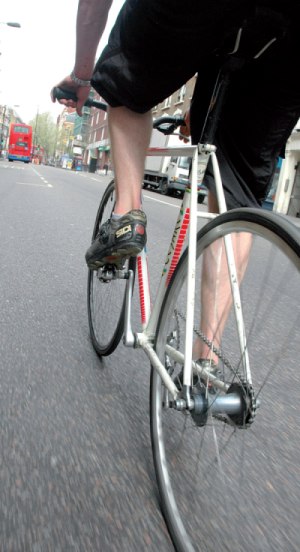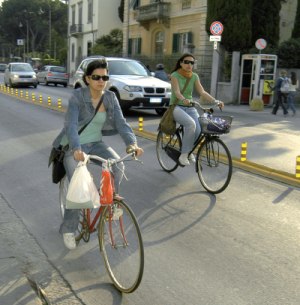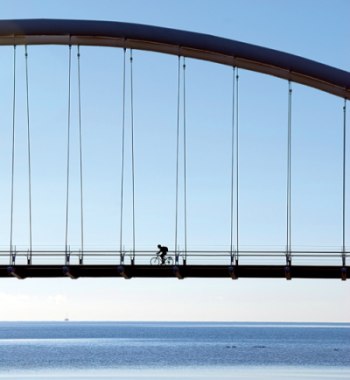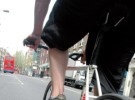Riding to work is enjoyable and gives you extra training. Greg Johnson discusses ways to keep you safe during rush hour.
It’s 6.00am Sunday morning and I slip as quietly as possible from under the covers and creep around my bed to pick up the small pile of cycling gear that I laid out the night before. My wife and children are sleeping soundly. I know which floor boards to step on and which will send a creak echoing up the hallway. Quickly and quietly I dress, fill a water bottle, slip a banana in a jersey pocket and navigate the patchy light to collect whichever bike I’m riding from under the house. Like a naughty schoolboy I sneak out and pray that my kids will sleep as long as possible. I’m touched by a guilty feeling as I saddle up for a weekend ride – a few stolen hours of escape from the weekly routine of my day job. I feel guilty for leaving the responsibilities of family life for something which is pure indulgence and just for me. With four kids, it’s no small thing for my wife to be left with them after caring for them all week. Sorry, I thought this article was about commuting? Well, it is. You see the guilt I feel on the weekend is non-existent during the week as I happily cycle my way through the 45km round trip to work. If you love to ride, commuting is the ideal way of getting more time on the bike without significantly affecting your lifestyle. My journey, including the shower at the other end takes about 50-60 mins, which is the same or better than public transport! Commuting also saves lots of money. I save about $2,500 on public transport costs every year (and if you use a car, double or triple that number!) This is money which I then set aside for spending on bikes and gear. It definitely helps with the negotiations with the financial controller of the family! Finally, commuting is great training. With some regular stops and starts it can be a form of interval training and is great for developing power. Plus, because you get to ride daily, the cumulative effect of the training is significant. I can remain competitive racing on the road or track simply by commuting to and from work.

Staying Safe
Perhaps the biggest issue most people face when thinking about commuting is that of safety. Ideally we’d all have bike paths leading from our houses to our workplaces, but Australia is still relatively poor in cycling infrastructure and so for most of us this means being comfortable with riding on the road. Whilst riding on the road is a risk, there are lots of basics that I apply daily and have kept me safe in over five years of daily commuting on a busy highway:
Be visible
This includes wearing visible clothing (avoid black) and some form of reflective clothing or backpack.
Lighting
Do not skimp on lights. Get something that is super visible such as the Planet Bike Super Flash. Batteries are cheap and this light is daytime visible, so use it both in the morning and evening. Front lights using high power LEDs are now very cheap and highly effective. Do not overlook the use of a front light—it helps cars turning off side streets to see you coming!
Maintain your bike
Make sure your bike is kept in good working order. The two most important things to look after are your tyres and your brakes. These are the things that keep you in contact with the road and out of harm’s way.
 Learn the road
Learn the roadLearn the flow of traffic and the way the lanes operate on the roads you’ll be riding. Australia has a notorious number of ‘s-lanes’. These are lanes which abruptly end, forcing you to merge right. My golden rule is that if you’re uncertain whether you can merge safely, slow and stop and wait for an opportunity. Do not ride in a lane with parked cars. The risk of doors opening and throwing you into the path of a car is too high!
Ride in the middle of the lane
Probably the biggest mistake new commuters make is riding in the very left of the lane. This encourages motorists to try and sneak past you and you’ll end up forced into gutters where you’re likely to end up having an accident.
Ride at speed
If you cannot comfortably maintain a speed of close to 30kph on a flat stretch of road, consider using footpaths or secondary roads. My average rolling speed would be up around 40km/h for most of the journey to and from work and this speed makes it much easier to integrate with the traffic.
Logistics
Commuting is relatively easy to organise from a logistical point of view. Most workplaces will have facilities to store a bike and will provide showers and change facilities. If they don’t, ask them to. Responsible employers should provide these amenities. I keep my suits, shoes and belts at work. Daily, I ride with a backpack into which I pack a business shirt (yes, you can fold a shirt and have it come out the other end crease free!), underwear, socks, tie and my lunch. As standard in my pack I also have a basic multi-tool, tyre levers, spare tube, patches and a pump so that I can fix pretty much anything on the road if I need to.
Getting Started
If you’ve never commuted before I strongly encourage you to give it a go. You don’t have to do it every day. Start with one or two days and before long you’ll probably find yourself wanting to ride every day. If you’re unsure about the best route, try out a route on the weekend at times when the roads are less busy. Finally, if you can, find someone in your area who already commutes and is willing; ask them to accompany you on your first few rides. I’ve done this for lots of people and it’s helpful because I can point out to them any peculiarities or hazards of the journey. If you want more information about commuting, particularly in Sydney, feel free to contact me at greg@velociti.org

 Learn the road
Learn the road


